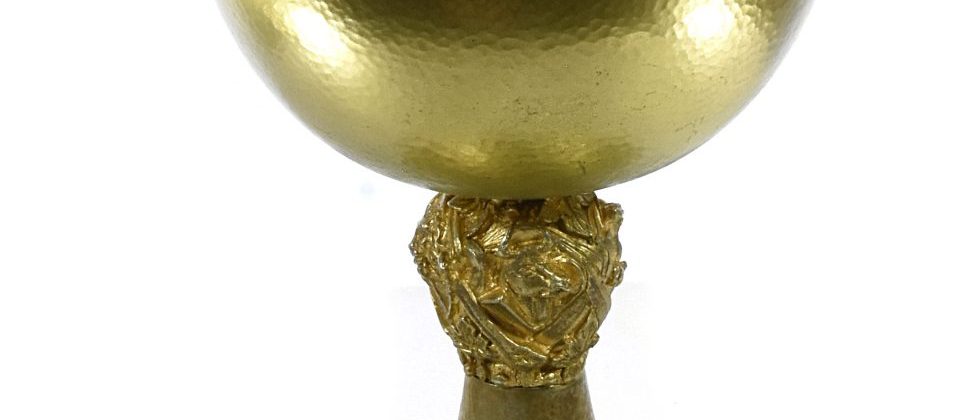
Autor: Desconhecido
Material/Técnica: Metal dourado/fundição
Século: XX
Procedência: Catedral do Bom Jesus de Cuiabá
Dimensão: 18x13cm
Dados Histórico: Peça doada a Catedral Metropolitana Basílica do Senhor Bom Jesus Cuiabá pelo Papa João Paulo II em sua visita na data de 1991.O cálice, do latim calix ou do grego kylix que era usado nos simpósios, é um recipiente destinado a conter líquidos. É usado concretamente em certos rituais cristãos para conter o vinho com água, sendo apresentado no altar. Na missa cristã, o cálice representa o Santo Graal, ou seja, o cálice que Jesus Cristo teria usado n a Última Ceia. É usado na Liturgia eucarística e no Rito da Comunhão. Antes e depois desses momentos, ele fica vazio, de forma que água e o vinho que serão usados na Consagração ficam em recipientes à parte, as galhetas. Objetos e alfaias que acompanham o cálice Junto ao cálice, encontramos sempre: A patena, que leva consigo a hóstia grande. O sanguíneo, um pano retangular e comprido que serve para purificar, ou seja, limpar o cálice após a Comunhão. A pala, que serve para cobrir o cálice. O corporal, pano no qual se coloca o cálice, a patena e as âmbulas.
Author: Unknown
Material / Technique: Golden metal / casting
20th Century
Origin: Cathedral of Good Jesus of Cuiabá
Dimension: 18x13cm
Historical Data: Piece donated to the Metropolitan Cathedral Basilica of Senhor Bom Jesus Cuiabá by Pope John Paul II on his visit in 1991. The chalice, from the Latin calix or the Greek kylix that was used in the symposia, is a container designed to contain liquids . It is used concretely in certain Christian rituals to contain wine with water, being presented at the altar. In Christian mass, the chalice represents the Holy Grail, that is, the chalice that Jesus Christ would have used in the Last Supper. It is used in the Eucharistic Liturgy and the Rite of Communion. Before and after these moments, it is empty, so that water and wine that will be used in the Consecration are kept in separate containers, cruets. Objects and implements that accompany the chalice Next to the chalice, we always find: The paten, which carries the large host. The blood, a rectangular and long cloth that serves to purify, that is, to clean the chalice after Communion. The visor, which serves to cover the chalice. The corporal, cloth on which the chalice, paten and ambulas are placed.

